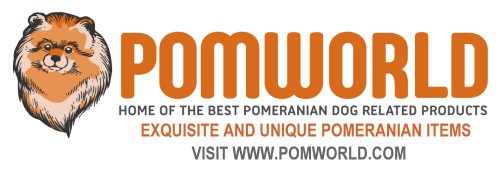Last Updated on 09/02/2024 by Dochlaggie. Post first published on April 27, 2023.
A basic understanding of Pomeranian coat stages is beneficial for any Pom owner. Pomeranians are known for their thick and fluffy coats that contribute to their cute appearance.
If you are looking for a top resource to help you understand the various stages of your Pomeranian’s coat, this is the perfect guide. It details what each coat stage looks like and how to care for your dog during that specific type of fur stage.
When Do Pomeranians Get Their Full Coat?
If you’re a first-time Pomeranian owner, you might be curious about when do Pomeranian puppies get fluffy.
From puppyhood into adulthood, a Pomeranian’s coat evolves to a genetically predetermined length. Your Pomeranian is supposed to have a beautiful fluffy coat, and they do, except around their face.
Pomeranian puppies have a smooth, single-layer puppy fur when they are born. At birth, this single coat is very short but grows quickly with each passing day.
A Pomeranian’s coat usually takes about one to two years to fully grow and become fluffy adult Pomeranian fur. As a Pom puppy matures, their puppy coats fall out, and their new fluffy adult coat will grow by the time your Pomeranian is 1-year-old.
Your Pom can have a coat that’s less fluffy and this is completely normal and is not a cause for concern. Be patient and don’t worry if your Pomeranian is 1 year old and still doesn’t have their “fluffy” coat yet, it may just be a matter of time.
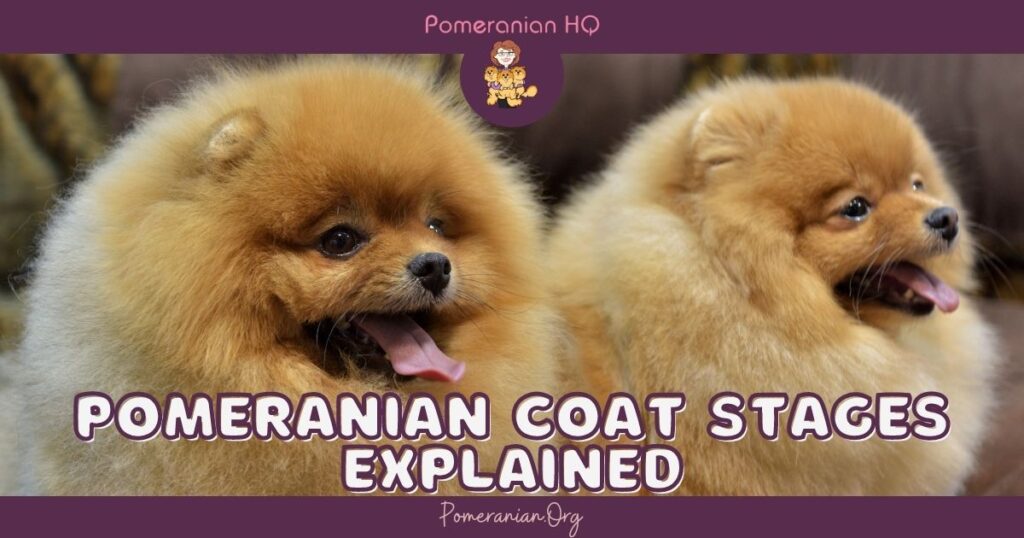
Pomeranian Hair Growth Stages
Pomeranian puppies go through many changes, including shedding their puppy fur. An interesting element to know is that a Pomeranian puppy is born with all of the hair follicles that the dog will ever have. Hair follicles are the small openings in which each hair shaft grows. The Pomeranian has a double coat, a shorter inner layer, and a long outer layer.
Newborn Pomeranian Pups
Newborn Pom puppies are born looking like smooth-coated dogs. As they mature, the fur will grow quickly, in the already-present hair follicles. At eight weeks most Pomeranian puppies are cute balls of fluff.
This soft puppy coat falls out and is gradually replaced with an adult coat. This begins when a Pomeranian puppy is anywhere from 3 to 6 months old. This is often called the Pomeranian puppy ugly stage.
The soft puppy coat falls out more quickly than adult fur grows. So, during this stage, a Pomeranian puppy’s fur may appear patchy and shaggy.
It is for this reason that some Pomeranian puppies have finer, thinner, and shorter coats than their adult counterparts.
When one refers to Pomeranian puppy shedding, this actually is the transitional phase of puppy to adult coat (Pomeranian puppy ugly stage). While some puppy fur will indeed shed off, this is in fact a time of increased hair growth.
During the puppy transition, the Pomeranian coat may appear shaggy, as the puppy coat falls out before adult fur has a chance to replace it. This is normal, as puppy coats can fall out more quickly than adult coats grow. The hair loss associated with growth is normal as long as your Pom puppy is otherwise healthy.
This coat change or puppy uglies is most prominent starting at 4 months old and by the time a Pomeranian puppy is 9 to 12 months old, he will have his adult coat. Remember that the coat will then continue to grow and renew by year-round, gradual shedding.
During the puppy uglies, it is very common for the Pomeranian coat to change colors, and markings may decrease or increase. Newer hairs may be darker or lighter.
This can continue throughout puppyhood, which can last until Pom puppies are a year old.
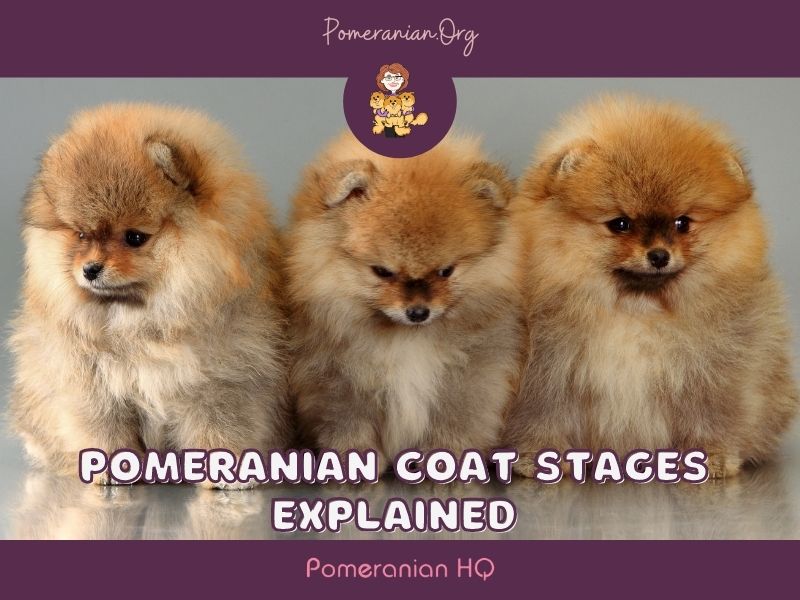
When Do Pomeranian Puppies Get Fluffy?
The word “fluffy” might make you think of a cuddly lapdog, but it also refers to the soft fur coat Pomeranians have at eight weeks old and later on when they develop their full adult coat.
An eight-week-old Pomeranian puppy should have a fluffy baby coat. By the time this dog is nine months of age, the puppy coat should have been replaced with a full adult coat.
Most Pomeranians will then grow through another coat shed between 12 and 18 months, I call this stage the junior molt. By the time your Pomeranian dog is three years old, he should have a full, glorious fluffy coat.
Post Partum Shedding
After weaning a litter, females will usually drop all of their coat and stop producing estrogen. This fur loss is due to hormone changes that occur and is not a reason for concern. The Pom’s coat will usually completely grow back in 6 months.
Growth Cycles of Pomeranian Coat
Once a Pomeranian puppy has replaced his puppy fur with an adult coat, it then goes through the following coat growth cycle for the rest of its life.
- Anagen phase: The first cycle is the anagen phase, which is the active growth phase. During this phase the coat reaches its full length, determined by genetics and breed.
- Catagen phase: The next phase, known as the transient catagen phase, signals the end of growth.
- Telogen phase: That phase is a lead-in to the resting, non-growth phase known as the telogen phase. Old loose hairs in the telogen phase are pushed out, called shedding.
The adult Pomeranian coat is made up of a short, dense undercoat and the outer coat consists of longer hair. It’s the outer coat that makes a Pomeranian look glamorous and fluffy. A Pomeranian’s coat can be trimmed lightly but should never be shaved. Once shaved, your Pomeranian coat may not grow back as it should.
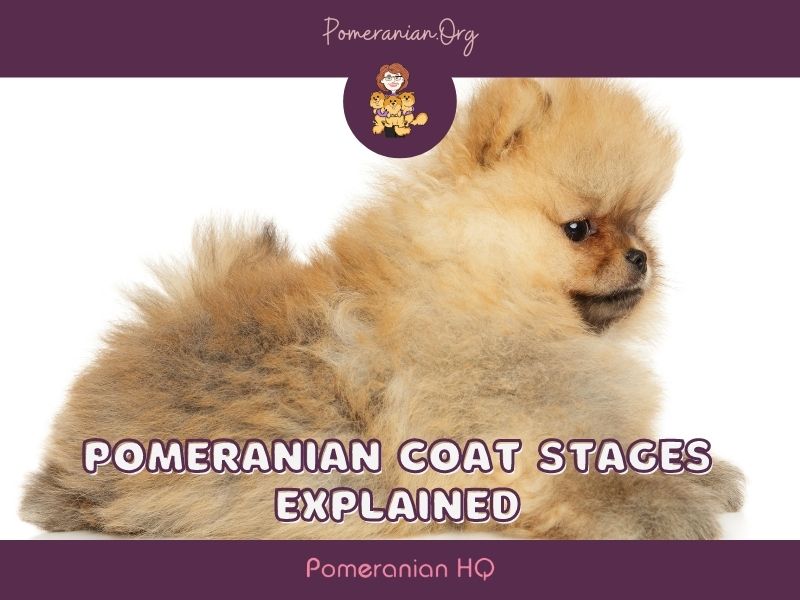
My Pomeranian Has Flat Fur?
If you have a Pomeranian puppy, it’s too early for you to worry about their coats.
There are different reasons why your Pomeranians may not be so fluffy. Let’s take a look.
- Genetics: Genetics and health issues can play a part in how fluffy Pomeranian’s coat appears. The most common reason for your Pomeranian’s not-so-fluffy coat is likely due to their lineage. Whatever their parents have, they will likely inherit.
- Diet: Diet has a huge effect on your Pomeranian’s coat. Good nutrition can determine how fluffy your Pomeranian’s coat is. Ensure your Pom is getting all vital vitamins, minerals, and antioxidants in their diet. This will contribute to a healthier immune system, skin, and coat.
- Grooming: Being a double-coated dog means shedding! This is exactly why you need a regular brushing routine to maintain your Pomeranian’s coat.
- Dry weather: Dry weather can take a toll on your Pomeranian’s skin and hair, and the coat will suffer as a result. Dry weather can make a Pom’s fur not so fluffy as dry air can affect their skin and fur coat.
- Health issues: Undiagnosed health issues can cause a Pomeranian’s fur coat to be less than fluffy. Some health issues can start with symptoms that show on your Pomeranian’s skin and coat. These problems can lead to flat fur in Poms.
- Age: Age can also play a role in how fluffy a Pomeranian’s coat will be. If Po. is an incredibly young puppy, it may be best to ignore how their fur looks and focus on good nutrition, training, and overall health of your puppy. Over time, a Pomeranian will begin to change and grow in their adult coat. This can take a while, and dog parents won’t likely see that fluffy coat for some time.
How to Make a Pomeranian Fluffy
It’s understandable that fluffy coats look great, are desirable, and make your Pomeranian puppy extra cuddly. Keeping your Pom looking incredible is all about making their coat fluffy and keeping a Pomeranian’s fur healthy.
But not all Pom coats are alike, and they require a lot of work and attention to stay glamorous and amazing. To help your Pomeranian puppy grow a fluffy and healthy coat, they need a healthy diet, a good grooming routine, and Omega-3 and Omega-6 fatty acids.
Here are some tips to encourage a soft, fluffy, and healthy Pomeranian coat.
- Have a regular brushing routine: A Pomeranian majestic appearance requires daily brushing sessions. Regular brushing increases the production of skin oils. Brushing energizes their skin and promotes the hair follicles’ growth. By brushing regularly, you are giving your Pomeranian’s coat the best chances of keeping clean, removing dead fur and fluffy.
- Bath with the right shampoo: It is vital to use the right shampoo that is specifically tailored for Pomeranians. Opt for a mild pH balanced shampoo to avoid stripping away the natural oils from your Pomeranian’s skin. Remember to rinse thoroughly with lukewarm water as shampoo leftovers can irritate your dog’s skin.
- Feed a healthy diet: Lack of key nutrients is a major reason of poor coat conditions. For your Pomeranian puppy’s coat to be fluffy, you need to feed them the right food with the right nutrients.
- Pack on the omega: Omega-3 and Omega-6 fatty acids are vital to keeping your Pomeranian’s coat fluffy. Make sure to give your Pom Omega 3 & 6 supplements in moderation. Too much could give your Pomeranian an upset stomach.
- Protect your Pomeranian against parasites: Fleas and ticks irritate your Pomeranian’s coat and skin. It makes your Pom constantly scratch and bite itself. Parasites can both damage your Pomeranian’s coat and cause issues for your dog’s health.
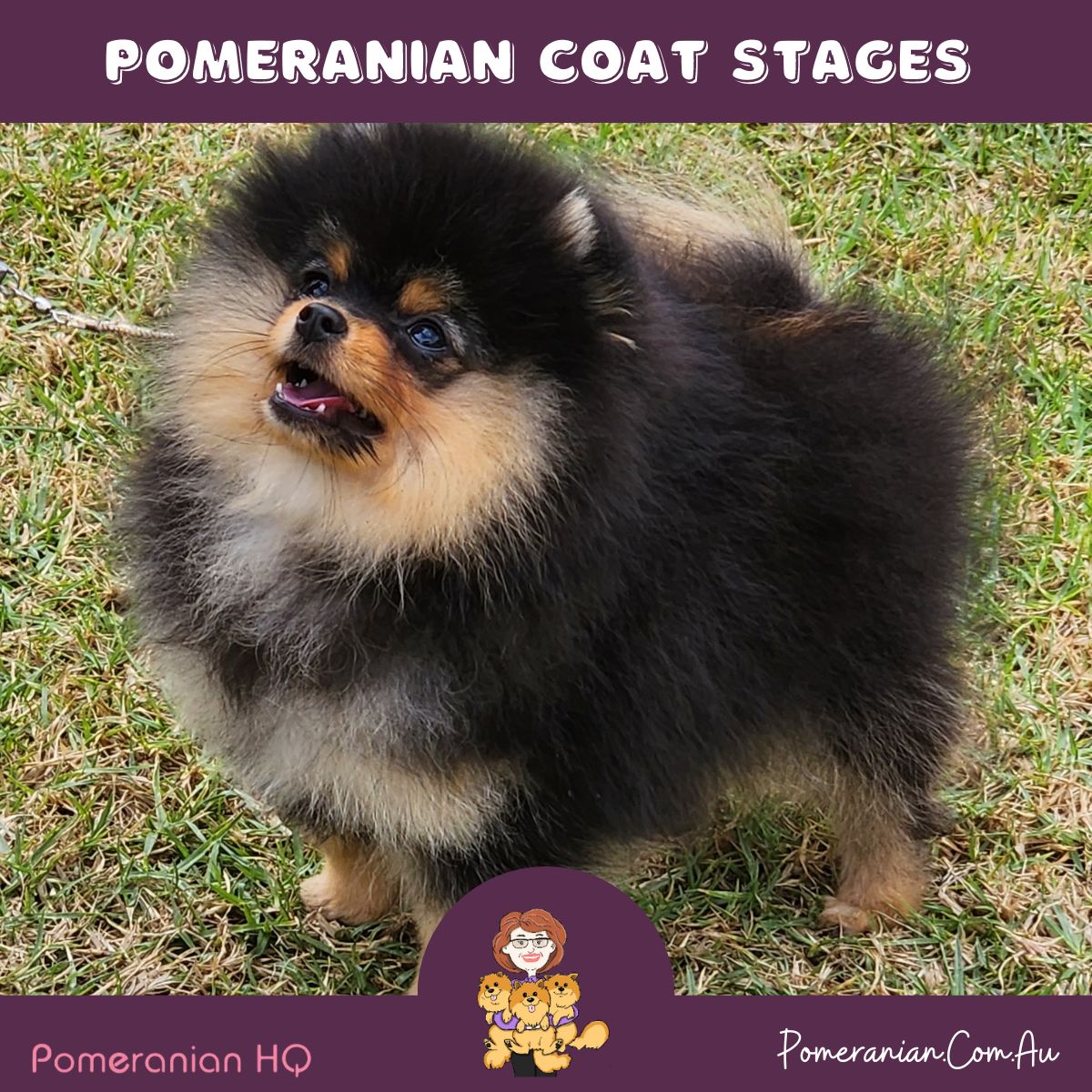
A Few Grooming Tips for Pomeranians
Here are some precautions that you should consider while grooming your Pomeranian:
- Never use any human shampoo for Pomeranians. They contain chemicals that can harm your little furry friend.
- Thoroughly rinse the shampoo out of your Pomeranian’s fur. This will help to prevent any skin damage or allergies.
- Never shave your Pomeranian unless recommended by your vet. These coats serve a purpose based on what the dog was bred to do. Shaving your Pom can lead to sunburn, allergies, dryness, and other skin conditions.
- There are various dog detanglers that you can use to help make brushing easier for your Pomeranian.
- During the shedding season, brush your Pomeranian’s hair daily. This will rescue you from loose hair flying around your house.
- Grooming will help to remove dead hair and prevent mats and tangles.
- Take your time, be gentle and make grooming a positive experience for your Pomeranian.
- You do not need to bathe your Pomeranian every week. Ask your breeder or groomer how often you should be bathing your Pom. Overbathing is not recommended as it can also cause many skin conditions.
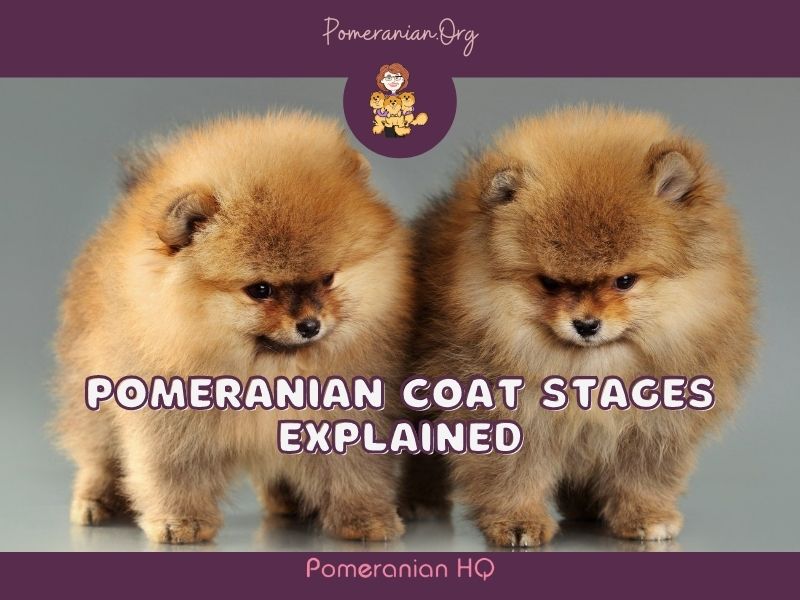
Pomeranian Coat Stages Conclusion
At the end of the day, all Pomeranians are beautiful in their own way just as they are, they just need good care and attention. Whatever their fur looks like, if Pomeranians are healthy, that is all that matters anyway!
Copyright Pomeranian.org. All Rights Reserved.
References and Further Reading:
[1] Official Standard of the Pomeranian (AKC). American Kennel Club, 2011.
[2] English Kennel Club Pomeranian Breed Standard, 2017.
[3] Denise Leo, The Pomeranian Handbook.
[4] Milo G. Denlinger “The Complete Pomeranian.”
[5] Kimbering Pomeranians “1891-1991”.
[6] William Taplin’s “The Sportsman’s Cabinet.”
[7] E. Parker “The Popular Pomeranian.”
[8] Lilla Ives “Show Pomeranians.”


